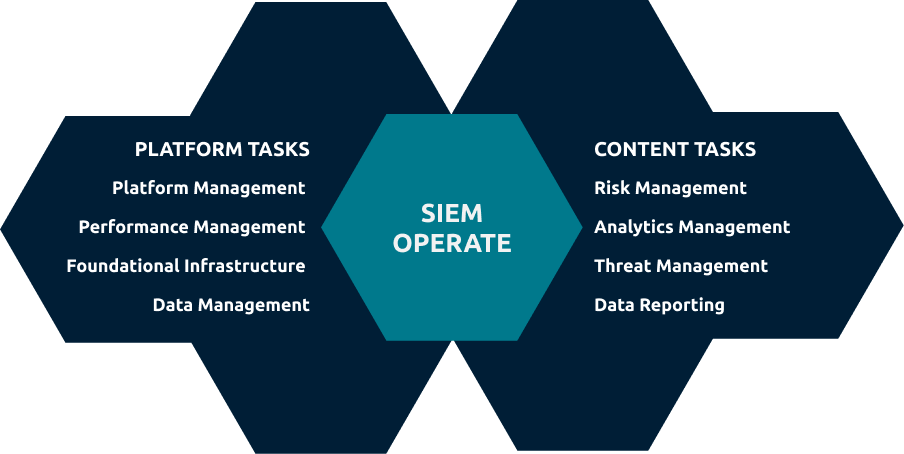
In our experience of working with hundreds of organisations across Finance, Health and Communications, we’ve observed many common issues when it comes to SIEM operation after its initial implementation. Keeping a threat management platform delivering and protecting over time is a difficult undertaking, requiring increasing time, energy and resources. External threats are increasing, business needs change, and tools are becoming more complex. It’s a lot to expect a SIEM to adapt to so much change, without some form of ongoing support.
The Four Phases of Apto’s Approach
A holistic apprach to SIEM is best practice for SIEM success. This begins with matching detective use cases to a threat register related to business risk. This approach provides visibility to all parts of the business; showing why use cases are implemented, how they match key risks and how they are mitigated. This approach also identifies any gaps in coverage, making it possible for your organisation to evaluate future security investments and “quick wins”.
At Apto, we break our approach to SIEM into four phases: Discover, Design, Deploy, and Operate. In this overview, we’re going to look at the details of SIEM Operation.
A SIEM without Support
When SIEM deployments are left to grow organically and without the right attention, teams frequently have to undertake large and expensive internal projects to repair issues that occur. It’s frustrating that correcting issues and repairing the platform takes so much time, and especially so when root cause sometimes remains.
A minimally maintained or poorly monitored SIEM platform could cause any number of repeating issues, including:
- Little or no evidence of security coverage evidence for the board.
- Unpredictable long-term licence costs and future unknowns
- Lack of accountability tying the SIEM to a risk or threat model
- Providing a reliable platform to the SOC (internal or external).
- Out-of-date or irrelevant threat intelligence in the SIEM
- Vendor lock-in and or poor integration with other platforms
- General lack of confidence in the ability of the SIEM tool itself
Unhelpfully, this is an issue that also gets worse over time. As more and more functionality is deployed to the platform, a greater risk builds up, rules fall out of date, updates are missed, and staff leave the organisation or are reassigned to other projects, leaving a large skills gap. Getting ahead of these issues and fixing them as they arise, is not only expensive and time-consuming but also impacts your business while the issues persist.
Strategic SIEM Operations: Ensuring Platform Success
A proactive, methodical SIEM operating approach is designed to help ensure that your platform remains fit for purpose, adapts to the needs of your business and that you can always justify how it is operating and most of all, why! Through a combination of proactive services, transitional support, and access to dedicated SIEM experts, you can gain a piece of mind and improve confidence that your chosen platform is doing what it should be.
Monitored SIEM – In Detail
Typically, SIEM operation comprises two components:
SIEM Operation – Platform, Data, Performance, Analytics, and Reporting Management;
Content Operation – Analytics, Threat, Risk, and Reporting Management.

A monitored SIEM comprises both Operate and Content tasks: several discrete daily, weekly, and monthly tasks essential to a well-optimised and functional platform. These tasks, such as app updates, platform maintenance and search optimisations are not overly complex but don’t require in-depth knowledge of the platform, and the time and capacity to complete the tasks routinely.
Frequently, within organisations, these essential tasks are left to team members whose primary function is not always SIEM engineering, such as SOC team members. Additionally, hiring, training, and maintaining coverage of these tasks typically require at least two people. (to ensure full coverage during holidays and sickness), This is something that not all organisations can commit to internally, and even if they do, can’t always find the right mix of skills to fill the gap in the team.
Often, the solution to this is an external provider or MSSP who will take on the Operation of SIEM, either in part on just the critical tasks that are identified or fully, by taking on full responsibility for the platform and its continued growth in line with the business. Either approach allows internal teams to focus less time on the day-to-day SIEM operation, and more time on other projects and platforms.
Bringing It All Together. Getting Your SIEM Back On Track.
In just a few examples above, we can see that the long-term operation of SIEM has many benefits. There is real value in managing and consistently completing daily, weekly, and monthly SIEM activities, across both platform and content, supplemented with reactive support and access to expert knowledge.
Keeping on top of your SIEM in a proactively managed way results in full coverage that provides you with complete peace of mind and a clear path ahead for your SIEM platform into the future and helps you achieve SIEM success.
Click here if you’d like to learn more about SIEM Operate or contact us today.
See how we can build your digital capability,
call us on +44(0)845 226 3351 or send us an email…



